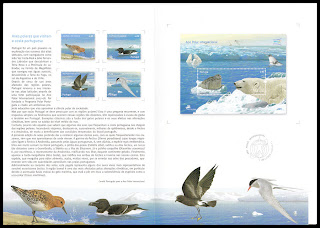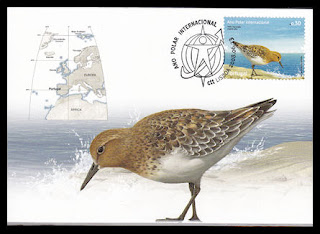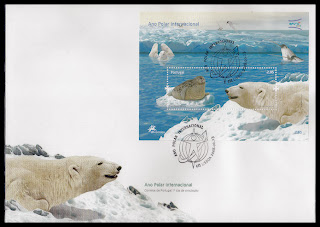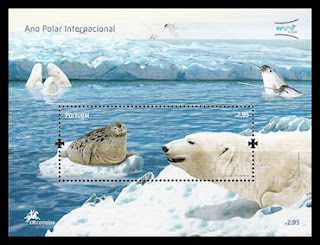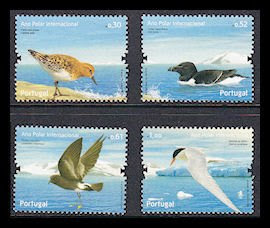
“Aves polares que visitam a costa portuguesa”
Portugal foi um país pioneiro na exploração dos oceanos das altas latitudes. Navegadores como João Vaz Corte-Real e João Fernandes Labrador que descobriram a Terra Nova e a Península do Labrador, ou ainda Fernão de Magalhães que navegou nas águas austrais, descobrindo a Terra do Fogo, no sul da Argentina e do Chile.
Depois de cerca de 500 anos afastado das regiões polares, Portugal renovou o seu interesse nas altas latitudes através de uma forte participação no Ano Polar Internacional 2007-08. Foi fundado o Programa Polar Português e criado um ambicioso projecto educativo que visa aproximar a ciência polar da sociedade portuguesa.
Mas por que razão Portugal se deve preocupar com as regiões polares? Esta é uma pergunta recorrente, e com respostas simples: os fenómenos que ocorrem nessas regiões tão distantes, têm repercussões à escala do globo e também em Portugal. Exemplos clássicos são a fusão dos gelos polares e os seus efeitos nas alterações climáticas, bem como na subida do nível médio do mar.
Contudo, poucos são aqueles que sabem que algumas das aves que frequentam a costa portuguesa nos chegam das regiões polares. Incansáveis viajantes, deslocam-se, sazonalmente, milhares de quilómetros, desde o Árctico e o Antárctico, de modo a beneficiarem das condições temperadas do litoral português.
A presente edição de selos pretende dar a conhecer algumas destas aves, com as quais frequentemente nos cruzamos, sem que nos apercebamos de onde vieram. A gaivina-do-Árctico (Sterna paradisaea) cujas longas migrações ligam o Árctico à Antárctida, passando pelas águas portuguesas, é, sem dúvida, a espécie mais emblemática. Uma ave muito comum no litoral português, o pilrito-das-praias (Calidris alba), nidifica no Alto Árctico, em terras tão distantes como a Gronelândia, a Sibéria ou a ilha de Ellesmere. Já o paínho-casquilho (Oceanites oceanicus) é, por excelência, o representante da Antárctida, nidificando nas ilhas daquele continente gelado. Finalmente, aparece a torda-mergulheira (Alca torda), que nidifica nas arribas do Árctico e inverna nas nossas costas. Esta espécie, que mergulha para obter alimento, acaba, muitas vezes, por se enredar nas artes dos pescadores, aparecendo sem vida em quantidades apreciáveis nas praias portuguesas.
Adicionalmente ao conjunto dos selos, esta pagela representa alguns dos seres vivos mais representativos do sensível ecossistema árctico. A região boreal é uma das mais afectadas pelas alterações climáticas, em particular devido à acentuada fusão estival do gelo marinho, que está a pôr em risco a sobrevivência de espécies como o urso-polar (Ursus maritimus).
Comité Português para o Ano Polar Internacional
(Baseado no texto do sítio oficial dos Correios de Portugal)
(English)
“Polar birds that visit the Portuguese coast "
Portugal was the pioneer in exploring the oceans of the high latitudes. Navigators such as João Vaz Corte-Real and João Fernandes Labrador who discovered the Newfoundland and the peninsula of Labrador, or Fernão Magalhães who sailed from southern waters, discovering the Tierra del Fuego in southern Argentina and Chile.
After about 500 years away from Polar Regions, Portugal renewed its interest in the high latitudes by a strong participation in the International Polar Year 2007-08. Founded Polar Portuguese and the Program established an ambitious educational project that aims to bring polar science of society. But why Canada should worry about the Polar Regions? This is a recurrent question, and answer simple: the phenomena that occur in these regions so far, have repercussions across the globe and also in Portugal. Classic examples are the fusion of polar ice and its effects on climate change and the rise in average sea level.
However, few are those who know that some of the birds that frequent the Portuguese coast in the polar regions arrive. Tireless traveler, traveling is, seasonally, thousands of kilometers from the Arctic and Antarctic in order to enjoy the temperate conditions of the Portuguese coast.
This edition of stamps want to make known some of these birds, with which often cross in, without it we realized where they came from. In-the-Arctic tern (Sterna paradisaea) whose long migrations connecting the Arctic to the Antarctic, through the Portuguese waters, it is undoubtedly the most emblematic. A very common bird in the Portuguese coast, the Sanderling (Calidris alba), nidify in the High Arctic, on lands as far away as Greenland, Siberia and the island of Ellesmere. But the Strom-petrel (Oceanites oceanicus) is par excellence the representative in Antarctica, nesting on the islands that icy continent. Finally, see the Razorbill (Alca torda), which nidifica cliffs in the Arctic and winter on our coasts. This species that dive for food, it often is by the tangle of fishing gear, life without appearing in appreciable quantities in Portuguese beaches.
In addition to all the stamps, this represents some of living more representative of sensitive Arctic ecosystem. The boreal region is one of the most affected by climate change, particularly due to the sharp melting of summer sea ice, which is put at risk the survival of species like the polar-bear (Ursus maritimus).
Portuguese Committee for the International Polar Year
(Based on the text of the Official Portuguese Post website)
Dados técnicos / Données Techniques / Technical Data
Obliterações do 1º dia em:
Oblitérations du 1er jour à:
First day obliterations in:
LISBOA / PORTO / FUNCHAL / PONTA DELGADA
Emissão / émission / issue:
2008/06/23
Selos / timbres-poste / stamps:
€ 0,30 - 280 000
€ 0,52 - 230 000
€ 0,61 - 230 000
€ 1,00 - 230 000
Bloco / bloc / souvenir sheet: com 1 selo / avec 1 timbre / with 1 stamp
€ 2,95 – 60 000
design: Nuno Farinha
papel / papier / paper: 110g/m2
picotagem / dentelure / perforation: 13 x cruz de Cristo /croix du Crist / Cross of Christ
formato / format / size: 40 x 30,6 mm
impressão / impression / printing: offset
impressor / imprimeur / printer: Cartor France
Folhas / feuilles / sheets:
Com 50 ex. / avec 50 ex. / with 50 copies
Bilhetes Postais / Cartes Postales / Poscards
4 x € 0,45
Sobrescritos de 1º dia / enveloppes du 1er jour / FDC:
C6 - € 0,55
C5 - € 0,74
Pagela / brochure
€ 0,69
 Carimbo 1º Dia / First Day Cancellation
Carimbo 1º Dia / First Day Cancellation



 Carteira Especial (Interior) / Presentation Pack (Inside)
Carteira Especial (Interior) / Presentation Pack (Inside)



